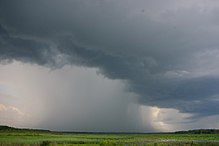 Global Information
Global InformationThunderstorm information
| Thunderstorm | |
|---|---|
 A typical thunderstorm over a field | |
| Area of occurrence | Primarily tropical and also temperate regions. |
| Season | Most common in spring and summer. (in temperate regions) Common in wet season. (in tropical regions) |
| Effect | Depends on the storm, may involve rain, hail, and/or high winds. May cause flooding or fires. |
| Part of a series on |
| Weather |
|---|
|
|
A thunderstorm, also known as an electrical storm or a lightning storm, is a storm characterized by the presence of lightning[1] and its acoustic effect on the Earth's atmosphere, known as thunder.[2] Relatively weak thunderstorms are sometimes called thundershowers.[3] Thunderstorms occur in a type of cloud known as a cumulonimbus.[4] They are usually accompanied by strong winds[1] and often produce heavy rain[1] and sometimes snow, sleet, or hail,[1] but some thunderstorms produce little precipitation or no precipitation at all. Thunderstorms may line up in a series or become a rainband, known as a squall line. Strong or severe thunderstorms include some of the most dangerous weather phenomena, including large hail, strong winds, and tornadoes. Some of the most persistent severe thunderstorms, known as supercells, rotate as do cyclones. While most thunderstorms move with the mean wind flow through the layer of the troposphere that they occupy, vertical wind shear sometimes causes a deviation in their course at a right angle to the wind shear direction.
Thunderstorms result from the rapid upward movement of warm, moist air, sometimes along a front.[5] However, some kind of cloud forcing, whether it is a front, shortwave trough, or another system is needed for the air to rapidly accelerate upward. As the warm, moist air moves upward, it cools, condenses,[5] and forms a cumulonimbus cloud that can reach heights of over 20 kilometres (12 mi). As the rising air reaches its dew point temperature, water vapor condenses into water droplets or ice, reducing pressure locally within the thunderstorm cell. Any precipitation falls the long distance through the clouds towards the Earth's surface. As the droplets fall, they collide with other droplets and become larger. The falling droplets create a downdraft as it pulls cold air with it, and this cold air spreads out at the Earth's surface, occasionally causing strong winds that are commonly associated with thunderstorms.
Thunderstorms can form and develop in any geographic location but most frequently within the mid-latitude, where warm, moist air from tropical latitudes collides with cooler air from polar latitudes.[6] Thunderstorms are responsible for the development and formation of many severe weather phenomena, which can be potentially hazardous. Damage that results from thunderstorms is mainly inflicted by downburst winds, large hailstones, and flash flooding caused by heavy precipitation. Stronger thunderstorm cells are capable of producing tornadoes and waterspouts.
There are three types of thunderstorms: single-cell, multi-cell, and supercell.[7] Supercell thunderstorms are the strongest and most severe.[7] Mesoscale convective systems formed by favorable vertical wind shear within the tropics and subtropics can be responsible for the development of hurricanes. Dry thunderstorms, with no precipitation, can cause the outbreak of wildfires from the heat generated from the cloud-to-ground lightning that accompanies them. Several means are used to study thunderstorms: weather radar, weather stations, and video photography. Past civilizations held various myths concerning thunderstorms and their development as late as the 18th century. Beyond the Earth's atmosphere, thunderstorms have also been observed on the planets of Jupiter, Saturn, Neptune, and, probably, Venus.
- ^ a b c d "thunderstorm | Definition, Types, Structure, & Facts". Encyclopedia Britannica. Retrieved 14 January 2021.
- ^ "Weather Glossary – T". National Weather Service. 21 April 2005. Retrieved 23 August 2006.
- ^ "NWS JetStream". National Weather Service. Retrieved 26 January 2019.
- ^ "Cumulonimbus clouds". Met Office. Retrieved 14 January 2021.
- ^ a b "Thunderstorms | UCAR Center for Science Education". scied.ucar.edu. Retrieved 14 January 2021.
- ^ National Severe Storms Laboratory. "SEVERE WEATHER 101 / Thunderstorm Basics". SEVERE WEATHER 101. National Oceanic and Atmospheric Administration. Retrieved 2 January 2020.
- ^ a b "Thunderstorms and Tornadoes". www.ux1.eiu.edu. Retrieved 14 January 2021.
